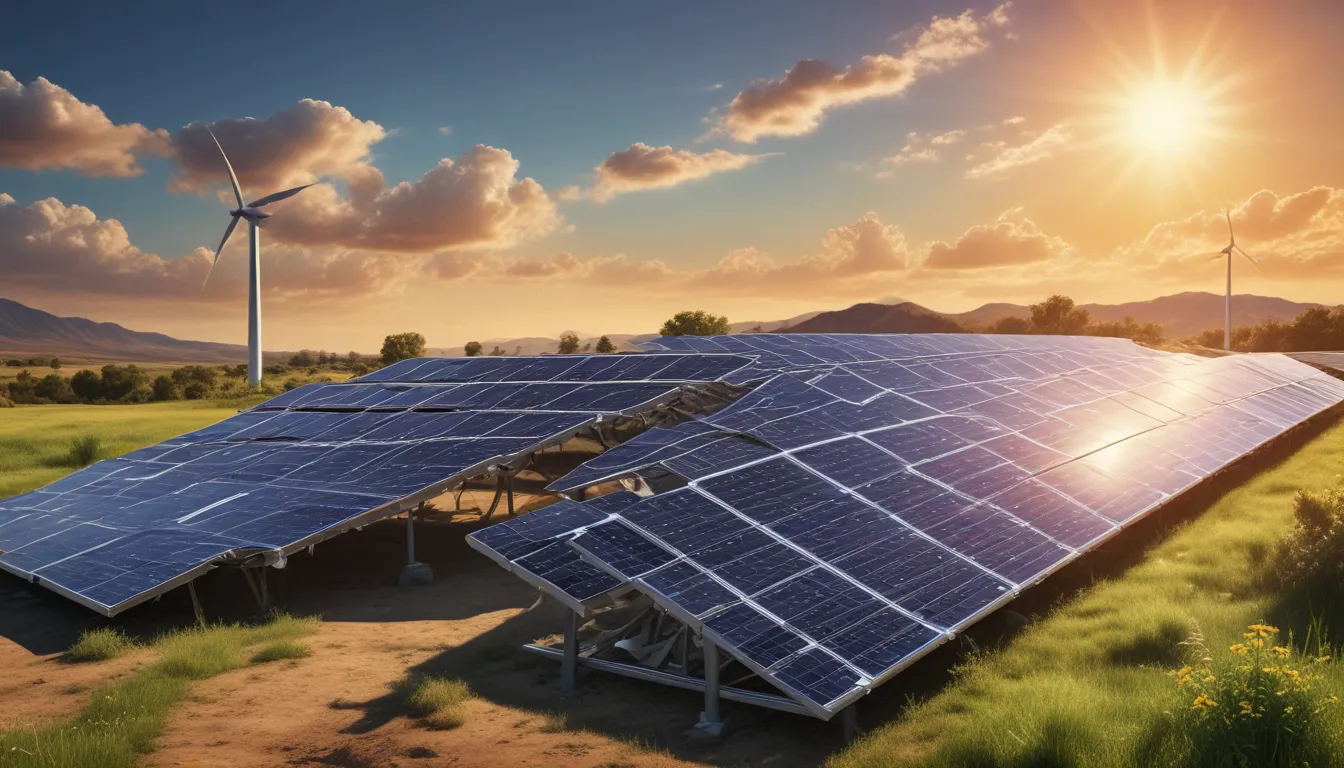A Note About Images: The images used in our articles are for illustration purposes only and may not exactly match the content. They are meant to engage readers, but the text should be relied upon for accurate information.
Welcome to the captivating realm of solar power, where the photovoltaic effect reigns supreme as a revolutionary force in energy production. The photovoltaic effect, a scientific principle that converts sunlight into electricity, has reshaped the landscape of power generation, paving the way for cleaner and more sustainable energy solutions.
Key Takeaways:
- The photovoltaic effect converts sunlight into electricity, powering our homes and devices while reducing greenhouse gas emissions, shaping a sustainable energy future.
- Photovoltaic technology is versatile, durable, and expanding globally, providing clean and reliable power, creating job opportunities, and driving sustainable solutions.
Harnessing Solar Energy: The Power of the Photovoltaic Effect
At the core of solar power lies the photovoltaic effect, a process that transforms solar energy into electrical energy. This remarkable phenomenon occurs when certain materials, known as semiconductors, interact with light to generate an electric current.
A Revolutionary Discovery: The First Photovoltaic Cell in 1839
The journey of the photovoltaic effect traces back to 1839 when French physicist Edmond Becquerel made a groundbreaking discovery. He observed that certain materials could produce small amounts of electric current when exposed to light, laying the foundation for the development of photovoltaic cells.
Advancements in Efficiency: The Evolution of Photovoltaic Cells
Over the years, technological innovations have significantly enhanced the efficiency of photovoltaic cells. From modest beginnings with early solar cells achieving only 1-2% efficiency, today’s commercial solar panels boast efficiencies of up to 20-22%, marking a remarkable progress in harnessing solar energy.
Generating Power Anytime, Anywhere: Solar Panels on Cloudy Days
Contrary to popular belief, solar panels can generate electricity even on cloudy days by harnessing diffuse sunlight. This ability to convert light into electricity makes solar panels a reliable source of power, irrespective of weather conditions.
Versatility in Action: Integrating Photovoltaic Technology into Various Applications
The versatility of photovoltaic technology extends beyond rooftops and solar farms. From portable chargers to solar-powered clothing, the photovoltaic effect finds innovative applications across diverse industries, showcasing its adaptability and potential.
A Sustainable Solution: Reducing Greenhouse Gas Emissions with Solar Power
Renewable energy sources like solar power heavily rely on the photovoltaic effect to mitigate greenhouse gas emissions. By harnessing the sun’s energy, photovoltaic technology contributes to combating climate change and fostering sustainable energy practices.
Exploring Materials: The Diversity of Photovoltaic Cells
Photovoltaic cells can be crafted from a variety of materials, including traditional silicon, thin-film options like cadmium telluride and copper indium gallium selenide (CIGS), and emerging technologies like perovskite cells. Each material offers unique advantages and applications in solar energy generation.
A Path to Progress: The Evolution of Photovoltaic Technology
Driven by the quest for efficiency and innovation, scientists and engineers worldwide continue to push the boundaries of photovoltaic technology. Through research and development, new materials and integration methods are explored to enhance the capabilities of solar power.
Clean and Silent: The Pollution-Free Nature of the Photovoltaic Effect
In stark contrast to fossil fuel-based power generation, the photovoltaic effect operates silently and emits no harmful pollutants. This environmentally friendly characteristic makes solar power a clean and sustainable alternative for meeting energy needs.
Economic Benefits: Savings and Reliability with Photovoltaic Systems
Installing a photovoltaic system not only enables homeowners and businesses to generate their own electricity but also leads to substantial savings on utility bills. Additionally, excess energy can be fed back into the grid, providing financial benefits through credits or revenue.
Longevity and Low Maintenance: The Durability of Photovoltaic Cells
Solar panels are designed to withstand varying weather conditions and boast a long lifespan with minimal maintenance requirements. This durability ensures that photovoltaic systems offer a reliable and cost-effective source of renewable energy.
Global Expansion: The Growth of Photovoltaic Technology Worldwide
With the increasing demand for clean energy, the deployment of photovoltaic systems is expanding globally. Countries like China, the United States, and Germany lead the way in solar capacity installations, driving the transition towards sustainable energy sources on a global scale.
Beyond Earth: The Role of the Photovoltaic Effect in Space Exploration
NASA harnesses the photovoltaic effect for space missions, utilizing vast solar arrays on spacecraft and satellites to generate electricity for communication, research, and exploration beyond Earth. This application highlights the versatility and reliability of solar power.
Empowering Remote Areas: Bringing Electricity to Off-Grid Locations
Photovoltaic systems have the transformative ability to deliver electricity to remote and off-grid areas, providing access to clean and reliable power where traditional grid infrastructure is lacking. This capability enhances energy accessibility and sustainability in underserved regions.
Driving Sustainability in Transportation: Photovoltaic Technology in Electric Vehicles
The integration of the photovoltaic effect extends to sustainable transportation, where solar energy assists in charging the batteries of electric vehicles, promoting greener mobility solutions and reducing reliance on fossil fuels.
Job Creation: Opportunities in the Photovoltaic Industry
The growth of the photovoltaic industry has created a multitude of job opportunities in manufacturing, installation, research, and development. This sector emerges as a significant contributor to the global workforce, fostering innovation and employment in renewable energy.
Shaping the Future: The Enduring Impact of the Photovoltaic Effect
As advancements continue and adoption rises, the photovoltaic effect stands poised to play a pivotal role in shaping our energy future. Offering a clean and renewable alternative, solar power through the photovoltaic effect contributes to addressing global energy demands sustainably.
FAQs: Unveiling the Details
Q: What is the photovoltaic effect?
A: The photovoltaic effect is the process where certain materials generate an electric current when exposed to light, forming the basis of solar cell technology.
Q: How do solar cells work?
A: Solar cells, also known as photovoltaic cells, are devices that convert sunlight into electricity using semiconducting materials.
Q: Are solar panels expensive?
A: While there is an upfront cost to install solar panels, advancements in technology have decreased their price, leading to long-term savings on energy bills.
Q: Can solar panels be installed on any type of roof?
A: Solar panels can be installed on various roof types, depending on factors like orientation, shading, and structural integrity.
Q: How long do solar panels last?
A: Solar panels typically have a lifespan of 25 to 30 years, with proper maintenance potentially extending their longevity.
Embracing the Sun’s Energy: A Brighter Future Ahead
The photovoltaic effect continues to illuminate the path towards a sustainable and greener future, driven by the limitless potential of solar power. As we unravel the wonders of solar energy and its transformative impact, we embark on a journey towards renewable energy solutions that empower individuals, communities, and the planet at large.
Conclusion: A Brighter Tomorrow with Solar Power
In conclusion, the photovoltaic effect stands as a beacon of hope in the realm of energy production, offering a clean, renewable, and sustainable solution to our growing energy needs. From its origins as a scientific curiosity to its pivotal role in advancing solar technologies, the photovoltaic effect has reshaped the way we think about power generation.
With ongoing research and development, the future of photovoltaic technology holds immense promise, paving the way for greater efficiencies, innovations, and environmental benefits. As we embrace the sun’s energy through the photovoltaic effect, we propel towards a future fueled by clean and sustainable power, leaving a lasting legacy of environmental stewardship for generations to come.
Join us in celebrating the marvels of the photovoltaic effect and the boundless possibilities of solar power as we journey towards a brighter tomorrow, powered by the sun.
Credits and Acknowledgments
Our commitment to delivering engaging and credible content is upheld by real user contributions and meticulous editorial reviews. We dedicate ourselves to sharing accurate and insightful information, ensuring that each fact shared is both fascinating and reliable. Trust in our dedication to quality and authenticity as we explore and learn together in the realm of solar power.






